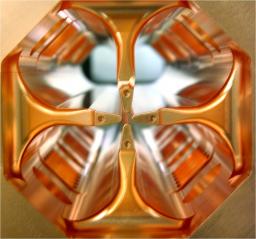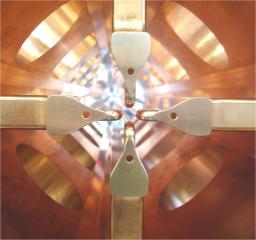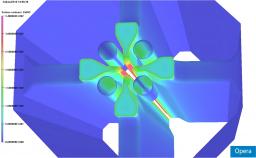The radiofrequency quadrupole, or RFQ, is a vital structure for ion linear accelerators. It fulfills the beam bunching and pre-acceleration functions that are essential for effective energy transfer in the upper stages, while ensuring particle confinement. Efforts to optimize RFQs are aimed at achieving the most effective bunching possible, at minimum power consumption, and with very low sparking rate. Reproducing the optimized amplitude of the electromagnetic field to within a few per cent requires manufacturing tolerances in the region of a few tens of microns at the pole ends.
The IPHI RFQ will consist of three coupled segments, two meters in length, operating at 352.21 MHz. Each segment comprises two sections, each made up of four brazed copper vanes. After each milling and brazing stage, RF measurements are performed using the bead pull technique to determine the relative errors of the three main electrical parameters of the RFQ, according to the axial position. Specifications of tuning slugs range and design of end plates and coupling plates have been modified to cope with the significant shifts observed during the brazing of section no. 3.
The RFQ for Spiral 2, which will be installed at the GANIL facility, will operate at 88.25 MHz. It will consist of a single five-meter-long segment, and will be able to generate 5 mA of deuterons at 40 MeV continuously. It was designed by SACM and SIS departments, who will also monitor construction. A meter-long prototype has been built and tested at rated power (40 kW). The ends of the electrodes are observed through a camera. Digital processing (correlator + interpolator + drift compensation) is carried out to track shifts over time, with a resolution in the region of 0.6 µm, which is well below pixel size (30 µm). Research Instruments GmbH is in the process of building the first RFQ section.
The Linac 4 RFQ will consist of a single 3 m segment operating at 352.2 MHz, and will produce 70 mA of H- ions in various LHC operating modes. It was jointly designed by teams from SACM, SIS and CERN. Section no. 1 has been precision-machined and brazed at CERN.
The techniques developed for these different RFQs are also of prime importance for the IFMIF and ESS projects.
• Accelerator physics and technology › High-Intensity sources and injectors
• Accelerators, Cryogenics and Magnetism Division (DACM)
• LEDA





